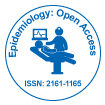Campylobacter Jejuni Infection in Israel: A National Study on Molecular Epidemiology
Received Date: Aug 26, 2022 / Published Date: Sep 24, 2022
Abstract
Over the past ten years, Israel has experienced an increase in the prevalence of Campylobacter infection, making it one of the industrialised nations with the highest rates, particularly among children under two years old. Using multiple methods, this study examined the molecular epidemiology of Campylobacter jejuni in Israel over a decade MLST (locus sequence typing) in conjunction with demographic data Select veterinary isolates (74) and representative clinical isolates from a sizable national repository were subjected to MLST. Using Poisson modelling, the distribution of age groups, ethnicity, and clinical source among different genotypes was assessed. The 512 isolates under study were given 126 different sequence types (STs), which were organised into 21 clonal complexes (CCs). Most human, chicken, and bovine STs grouped together among the top CCs. Since 2006, only three dominant STs have been identified. Patients carrying the most common CCs were similarly dispersed among densely populated areas. Patients with CC353 (relative rate (RR) 14 2.0, 95% CI 1.03e3.9, adjusted p value and CC42 infections had more blood isolates than those with CC257. Different age groups and ethnicities were distributed among the top CCs.
Citation: Agmon D (2022) Campylobacter Jejuni Infection in Israel: A National Study on Molecular Epidemiology. Epidemiol Sci, 12: 460.
Copyright: © 2022 Agmon D. This is an open-access article distributed under the terms of the Creative Commons Attribution License, which permits unrestricted use, distribution, and reproduction in any medium, provided the original author and source are credited.
Share This Article
Recommended Journals
Open Access Journals
Article Usage
- Total views: 1841
- [From(publication date): 0-2022 - Mar 31, 2025]
- Breakdown by view type
- HTML page views: 1518
- PDF downloads: 323
